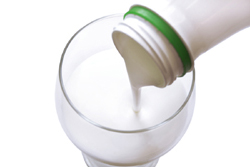What are bioactives?
- What are bioactives used for?
- How are bioactives incorporated into our food?
- Criticisms of bioactives
What are bioactives?
Bioactives are chemicals, chemical molecules and microbes (microscopic organisms) that have some biological effect on our bodies. Bioactive food components are bioactives that have been added to food. Bioactives are not essential for nutrition (i.e. you can’t be deficient in bioactives) but they are thought to offer some health benefits. Bioactives are usually substances that have been isolated or derived from plants and other living systems.
Milks and drinking yoghurts are commonly used to deliver bioactive food components. For example, probiotics or live bacterial cultures such as Lactobacillus can be added to yoghurts and other dairy foods. These microorganisms aid digestion by improving the microbial balance in the intestine or gut.
Waste products from the food industry also contain bioactives. For example, whey (a waste product in cheese production), contains proteins such as lactoferrin, which have anti-viral and anti-inflammatory properties.
What are bioactives used for?
Bioactives are normally present in our diets in small or trace amounts. By adding them to foods, we receive larger quantities of these bioactives and may receive associated health benefits.
Some common bioactives and their associated health benefits are:
| Bioactive | Associated health benefits |
|---|---|
| Plant sterols | Cholesterol reducing properties.Can be added to dairy spreads, cheeses, yoghurts, milks and juices. |
| Probiotics | Aids digestion and may have some positive effect on the immune system.Found in infant formula and milk products, most notably yoghurts. |
| Carotenoids | (E.g. alpha- and beta-carotene, lutein and lycopene) A range of health benefits, including aiding in the synthesis of vitamin A and acting as biological antioxidants, protecting cells and tissues from the damaging effects of free radicals. Lutein has been suggested to improve eye health.Derived from vegetables such as tomatoes, carrots, spinach, peaches and nectarines. Added to milk products. |
| Polyphenols | Antioxidant and cardiovascular benefits.Derived from fruits, particularly fruit skins. Can be added to milk. |
| Oligosaccharides | Selectively stimulate the growth of microflora in the intestine, particularly in the colon, to aid digestion.Found in vegetables such as onions, leeks and chicory roots. Added to drinks, milk-based infant formulas, confectionery,bakery products, yoghurts and dairy desserts. |
| Special fatty acids or derivatives of amino acids | Associated with brain development in infants and cardiac health in adults. A relatively well-known example is omega-3 oils, which provide energy in addition to benefiting human brain development and inflammatory responses.Added to milk-based products, juices, table spreads, salad dressings, sauces, breakfast cereals, baked goods, infant formulas and baby foods. |
Less common bioactives include dermatan sulphate, which is extracted from cow hides. Dermatan sulphate has anti-inflammatory effects, and can prevent blood clotting.
How are bioactives incorporated into our food?

New research at the Australian Commonwealth Scientific and Industrial Research Organisation (CSIRO) has found that bioactives can be protected using miniature capsules or microencapsulation. Microencapsulation encases bioactives within a thin film of proteins and carbohydrates only a few microns (one millionth of a metre) in diameter. The film protects bioactives during food processing, storage and cooking so that the bioactive ingredient is available after food consumption and digestion.
Criticisms of bioactives
Bioactive food components are usually linked with strong claims about health benefits. However, not all the claimed health effects are based on solid scientific evidence. Further, it is often unclear whether bioactive ingredients are present in foods in high enough quantities to confer a health benefit. The addition of bioactive components to food helps to promote a ‘healthy image’ for a product, thereby increasing its consumer appeal, and potential profitability. To ensure that consumers are not misled by manufacturers’ health claims, further research and regulation may be needed to ensure that bioactive ingredients can deliver their advertised health benefits.
More information
 |
For more information on food groups and components, see Types and Composition of Food. |
 |
For more information on nutrition, including information on nutrition and people, conditions related to nutrition, and diets and recipes, as well as some useful videos and tools, see Nutrition. |
References
- Food Science Australia. Delivering bioactive ingredients to targeted sites in the gastrointestinal tract [document on the Internet]. Victoria, Aust.: Food Science Australia. [cited 21 July 2008]. Available from: http://www.foodscience.csiro.au/ delivering-bioactives.htm
- Niemann B. Functional ingredients: How much should we add to foods? [document on the Internet]. Functional Foods Net. April 2008 [cited 21 July 2008]. Available from: http://www.functionalfoodnet.eu/ asp/ default.asp?p=7
- Mee P. Functional Foods: A dietician’s perspective [document on the internet]. Functional Foods Net. January 2008 [cited 21 July 2008]. Available from: http://www.functionalfoodnet.eu/ asp/ default.asp?p=7
- Roupas P, Williams PG. Regulatory aspects of bioactive dairy ingredients. Bulletin of the International Dairy Federation. 2007; 413: 16-26.
- CSIRO. Separating bioactives [document on the Internet]. Victoria, Aust.: Commonwealth Scientific and Industrial Research Organisation. 19 July 2006 [cited 21 July 2008]. Available from: http://www.csiro.au/ science/ ps20w.html
- Office of Dietary Supplements: National Institutes of Health. Summary of comments received in response to the Federal register notice (Federal Register Vol 69, No 179: Sept 16, 2004, pp 55821-55822): Defining bioactive food components [document on the Internet]. Maryland, USA: USA Government. 17 February 2006. [cited 21 July 2008]. Available from: http://ods.od.nih.gov/ Research/ Bioactive_Food_Components_Initiatives.aspx
- Hasler CM. Functional foods: Benefits, concerns and challenges: A position paper from the American Council on Science and Health. Journal of Nutrition. 2002; 132: 3772-81.
- CSIRO. Media release: Extracting ‘bioactives’ from agricultural and food processing streams [document on the Internet]. Victoria, Aust.: Commonwealth Scientific and Industrial Research Organisation. 12 December 2006 [cited 21 July 2008]. Available from: http://www.csiro.au/ news/ ps2l3.html
All content and media on the HealthEngine Blog is created and published online for informational purposes only. It is not intended to be a substitute for professional medical advice and should not be relied on as health or personal advice. Always seek the guidance of your doctor or other qualified health professional with any questions you may have regarding your health or a medical condition. Never disregard the advice of a medical professional, or delay in seeking it because of something you have read on this Website. If you think you may have a medical emergency, call your doctor, go to the nearest hospital emergency department, or call the emergency services immediately.








